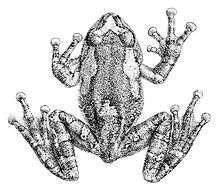Nasutixalus jerdonii
Nasutixalus jerdonii is a species of frog in the family Rhacophoridae. It is found in the northeastern India, in the West Bengal, Nagaland, Manipur, and Meghalaya states. It range might extend into the adjacent Nepal.[2] The specific name jerdonii honours Thomas C. Jerdon, an English herpetologist.[3] Common names Jerdon's bubble-nest frog, Jerdon's tree frog, and Jerdon's bush frog have been coined for this species.[1][2]
| Nasutixalus jerdonii | |
|---|---|
.jpg) | |
| Scientific classification | |
| Kingdom: | Animalia |
| Phylum: | Chordata |
| Class: | Amphibia |
| Order: | Anura |
| Family: | Rhacophoridae |
| Genus: | Nasutixalus |
| Species: | N. jerdonii |
| Binomial name | |
| Nasutixalus jerdonii (Günther, 1876) | |
| Synonyms[2] | |
| |
Taxonomy
This species was first described as Polypedates jerdonii in 1876 by Albert Günther.[2] Its subsequent placement has included various genera. In 2016, Sathyabhama Das Biju and colleagues erected a new monotypic genus for this species, Frankixalus; the name of the genus honours Franky Bossuyt from the Free University of Brussels.[4] However, just two days earlier, Jiang and colleagues had erected the genus Nasutixalus to accommodate this species and another, new species.[5] This gives priority to Nasutixalus.[6]

Description
Adult males measure 37–42 mm (1.5–1.7 in) and adult females, based on a single specimen, 47 mm (1.9 in) in snout–vent length. The snout is rather truncate and not protruding. The fingers have basal webbing while the toes have moderate webbing. The dorsal colouration is reddish-brown to brownish-grey. Various markings are present, including an X-shaped brownish-black marking in many specimens. Males have a vocal sac.[4]
.jpg)
Habitat and conservation
Nasutixalus jerdonii occurs in montane evergreen forests and secondary forests. It is an arboreal species. Males call from tree holes. The eggs are laid on the inner walls of water-filled hollows, and the tadpoles develop in water. They are oophagous.[4]
This species was for a long time only known from the type series collected in 1870.[1][7][8] However, populations were discovered in surveys conducted in 2007–2010.[4][7][8] The species is threatened by habitat disturbance caused by slash-and-burn agriculture.[4]
References
- Ohler, A. (2004). "Philautus jerdonii". IUCN Red List of Threatened Species. 2004: e.T58930A11858469. doi:10.2305/IUCN.UK.2004.RLTS.T58930A11858469.en.
- Frost, Darrel R. (2018). "Nasutixalus jerdonii (Günther, 1876)". Amphibian Species of the World: an Online Reference. Version 6.0. American Museum of Natural History. Retrieved 17 November 2018.
- Beolens, Bo; Watkins, Michael & Grayson, Michael (2013). The Eponym Dictionary of Amphibians. Pelagic Publishing. p. 104. ISBN 978-1-907807-42-8.
- Biju, S. D.; Senevirathne, Gayani; Garg, Sonali; Mahony, Stephen; Kamei, Rachunliu G.; Thomas, Ashish; Shouche, Yogesh; Raxworthy, Christopher J. & Meegaskumbura, Madhava (2016-01-20). "Frankixalus, a new rhacophorid genus of tree hole breeding frogs with oophagous tadpoles". PLoS ONE. 11 (1): e0145727. doi:10.1371/journal.pone.0145727. PMC 4720377. PMID 26790105.
- Jiang, Ke; Yan, Fang; Wang, Kai; Zou, Da-Hu; Li, Cheng & Che, Jing (2016-01-18). "A new genus and species of treefrog from Medog, southeastern Tibet, China (Anura, Rhacophoridae)". Zoological Research. 37 (1): 15–20. doi:10.13918/j.issn.2095-8137.2016.1.15. PMC 4834735. PMID 26828030.
- Sivongxay, N.; Davankham, M.; Phimmachak, S.; Phoumixay, K. & Stuart, B. L. (2016-08-05). "A new small-sized Theloderma (Anura: Rhacophoridae) from Laos". Zootaxa. 4147 (4): 433–442. doi:10.11646/zootaxa.4147.4.5. PMID 27515627.
- "'Extinct' tree frog rediscovered in India after 137 years". BBC News. 21 January 2016. Retrieved 21 January 2016.
- "Scientists find tree frog believed extinct for more than 100 years". The Guardian. 21 January 2016. Retrieved 17 November 2018.
